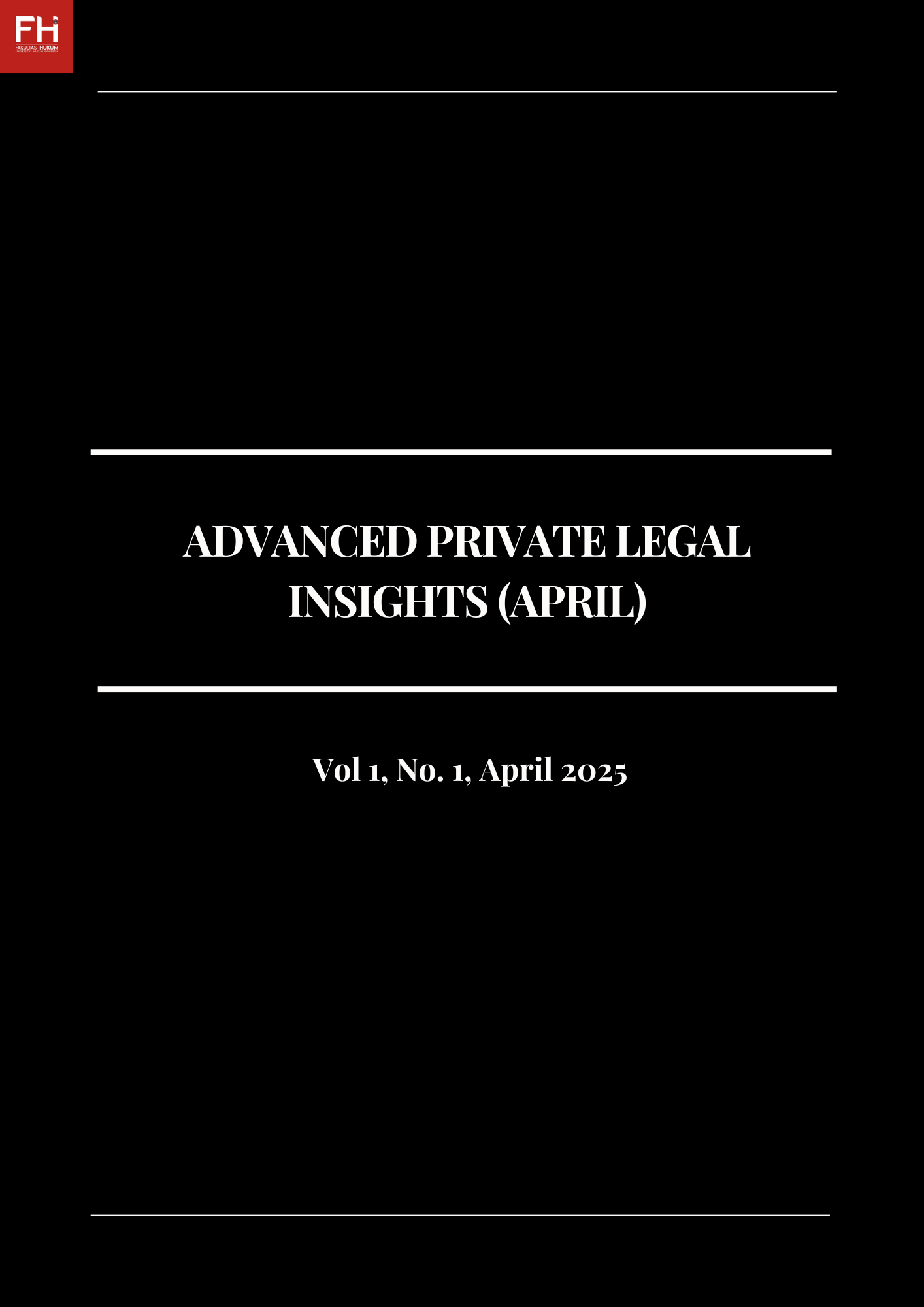Abstract
This study aims to analyze the legal position of e-stamp duty in electronic documents based on Indonesian laws and regulations, especially Law No. 10 of 2020 on Stamp Duty. Furthermore, it seeks to examine the legal impact of e-stamp duty misuse from a civil law perspective. This study employs a normative juridical research method, which involves examining legal theories, comparative laws, structure, and general explanations. The findings indicate that e-stamp duty holds a strong legal position as a validation tool for electronic documents under Law No. 10 of 2020 and Article 5 of the ITE Law. However, misuse of e-stamp duty, such as forgery or unauthorized use, can weaken document validity, making them inadmissible as evidence under Article 1869 of the Civil Code. Additionally, misuse undermines public trust in digital administration systems. This study recommends strengthening regulations related to e-stamp duty, including better legal protection for electronic documents, enhanced security systems to detect fraud, and increased public awareness regarding the importance of document validation using e-stamp duty. Law enforcement authorities are encouraged to take firmer action against misuse cases to deter fraud and enhance public confidence in Indonesia's digital administration system.
INTRODUCTION
Currently, the development of information technology has brought significant changes in various sectors, including the legal and public administration sectors. Digitalization of documents and transactions has become a global trend, with the aim of increasing efficiency, transparency, and security. One of the innovations that has developed in this area is the implementation of e-stamps as a means of validating electronic documents. In Indonesia, regulations regarding e-stamps have been regulated in Law No. 10 of 2020 concerning Stamp Duty. The implementation of e-stamps aims to replace physical stamps in various legal and administrative transactions. However, although e-stamps have a clear legal basis, challenges in their implementation still arise. Cases of misuse of e-stamps, such as forgery or use on invalid documents, are a major concern. This has implications for the validity of electronic documents and can weaken their function as legal evidence as regulated in Article 1869 of the Civil Code.[1] According to research conducted by several experts, one of the weaknesses in the e-stamp system is the lack of socialization and public understanding of its use. Many users do not understand the difference between physical stamps and e-stamps, so they are at risk of becoming victims of fraud.
On the other hand, the government continues to strive to strengthen regulations and monitoring systems for the use of e-stamps. One of the steps taken is the development of a more sophisticated authentication system, to ensure that e-stamps can only be used by authorized parties and in accordance with applicable legal provisions.[2] The success of e-stamp implementation also depends heavily on coordination between government agencies, the private sector, and the wider community. Without adequate support from various parties, the implementation of e-stamps has the potential to face obstacles that can hinder its effectiveness in digital transactions. The formulation of the problem of this study is What is the legal position of e-stamps in electronic documents based on laws and regulations in Indonesia? and What are the legal impacts of misuse of e-stamps in electronic documents from a civil law perspective?
METHOD
This study uses a normative legal method with a statutory approach and a conceptual approach. The study was conducted by analyzing primary, secondary, and tertiary legal materials related to e-stamps and their application in the legal system in Indonesia.[3] Primary legal materials consist of relevant laws and regulations such as Law No. 10 of 2020 concerning Stamp Duty, Law No. 11 of 2008 concerning ITE, and related Government Regulations. Secondary legal materials include legal journals, books, and scientific articles related to the use of e-stamps. Tertiary legal materials include legal encyclopedias and legal dictionaries that support understanding of the concepts in this study. The data collection technique was carried out through literature study, namely reviewing legal documents and literature that discuss e-stamps and their application in Indonesian civil law. Data analysis was carried out qualitatively normatively by reviewing existing legal concepts and linking them to the practice of implementing e-stamps in the Indonesian legal system.
DISCUSSION
Legal Position of E-Stamps in Electronic Documents Based on the Laws and Regulations in Force in Indonesia.
The legal status of e-stamps in Indonesia is one of the crucial aspects in the development of regulations that support the validity and legal force of electronic documents. With the increasing need for digital transactions in the era of technological transformation, e-stamps are presented as a replacement for physical stamps which have been an important element in legal documents. E-stamps are specifically regulated through laws and regulations to ensure that electronic documents that use them have a valid legal basis and can be legally recognized in the judicial and administrative systems.[4]
E-stamps not only serve to provide legal certainty, but also become a strategic step to answer the challenges in adapting the law to digitalization. In this context, e-stamps function as a legality marker recognized in electronic documents, so that their use can prevent legal disputes due to the unclear status of digital documents. Thus, e-stamps play an important role in integrating technological innovation with existing legal systems . Article 1866 of the Civil Code regulates the types of evidence recognized in civil law, one of which is a deed. These deeds, both authentic deeds made by authorized officials and private deeds, have legal force as evidence in the judicial process. This article is very important in terms of electronic documents because it relates to e-stamps, which function as one way to ensure that electronic documents made in digital transactions are valid. The valid requirements of an agreement are regulated in Article 1320 of the Civil Code, which consists of four main components:
- The parties agree to bind themselves voluntarily.
- Capacity of the parties, which means that the parties making the agreement must have the legal capacity to act.
- The main points of the agreement must be based on Article 19 of the Consumer Protection Law,
- The purpose of the agreement must not be contrary to law, morals, or general rules.
E-stamp is a digital stamp used to increase the evidentiary power of electronic documents, ensuring that the document has been received and approved by both parties with valid formal requirements. Because e-stamp can be integrated with electronic signatures to provide administrative validity to digital transactions, this process increases legal security.[5] Law No. 10 of 2020 confirms the position of e-stamp as a legal instrument used in electronic documents. E-stamp is present as an answer to the need for digital documents that are increasingly widespread in the digitalization era, especially in e-commerce transactions and online contracts. With e-stamp, the government can ensure that electronic documents have the same legal force as physical documents.[6] Electronic documents have an equal role to paper documents, as regulated in Article 5 paragraph (1) of Law Number 11 of 2008 concerning Electronic Information and Transactions (UU ITE). The article states that Electronic Information and/or Electronic Documents and their printouts are recognized as valid legal evidence. Before going any further, it is important to remember that the presence of a stamp in an agreement is not a requirement that makes the agreement valid or invalid. As quoted from Article 1320 of the Civil Code, an agreement can only be valid if it meets the following requirements:
- an agreement that binds both parties;
- the ability to make agreements;
- specific subject matter; And
- reasons that are not prohibited.
As regulated in Article 5 Paragraph (1) of Law Number 19 of 2016 concerning Amendments to Law Number 11 of 2008 concerning Electronic Information and Transactions (ITE Law), the recognition of electronic documents in Indonesia has a strong legal basis. The article firmly stipulates that electronic information, electronic documents, and their printouts are considered valid legal evidence. This evidence is equivalent to other evidence regulated in procedural law, both civil and criminal. In the legal proof process, this legality is the basis for recognizing digital documents. However, the effectiveness of the implementation of e-stamps still depends on the readiness of the infrastructure and the public's understanding of this system. Lack of understanding of the e-stamp mechanism can lead to errors in its use, resulting in the invalidity of documents. There are several challenges that must be addressed immediately. Strengthening a more reliable system is needed to address technological security threats such as forgery and cyber attacks.
In addition, a major obstacle to equitable implementation is the issue of digital infrastructure, especially in remote areas with limited internet access. The CPNS registration case study shows that technical disruptions caused by a surge in users are a major concern. This suggests that server capacity needs to be increased, system improvements, and a more user-friendly interface created. Lack of Adequate Infrastructure Many automotive manufacturers, especially those with distribution networks in remote areas or outside major cities, have difficulty providing adequate after-sales service. This is mainly related to the limited number of authorized workshops or service centers spread throughout the region, which means consumers have to travel long distances to get optimal after-sales service.[7] One of the main advantages of e-Meterai is the principle of efficiency. As stated by Hutabarat, the use of e-Meterai reduces distribution costs and the time required to obtain physical stamps. In addition, e-Meterai facilitates integration with digital administration systems, resulting in faster transactions and management of official documents.[8]
Legal Impact of Misuse of E-Stamps in Electronic Documents from the Perspective of Civil Law in Indonesia
Although e-stamps are very practical and easy to use, the problem of misuse and fraud remains. Therefore, stricter laws must be applied to violations related to e-stamps, including sanctions for those who sell and use fake stamps. In addition, it is necessary to develop a more transparent and secure system for verifying the authenticity of e-stamps.[9] Civil Law Liability: Article 1365 of the Civil Code states that the injured party can claim compensation if e-stamps are misused in the context of civil law. This liability includes compensation for losses caused by invalid documents, both material and immaterial. The injured party also has the right to cancel the agreement if the document is used as a basis. This is in line with the idea that invalid documents can be considered non-binding.
Therefore, stricter regulations must be implemented to address the legal impact of illegal use of e-Stamps, especially in the context of Articles 1868 and 1869 of the Civil Code, which state that documents using counterfeit stamps may lose their legal validity.[10] In addition, misuse of e-Stamps may result in the cancellation of agreements based on Article 1320 of the Civil Code, which states that documents with counterfeit e-Stamps are considered invalid.[11] As a result, the aggrieved party can file a civil lawsuit to obtain compensation as stipulated in Article 1365 of the Civil Code. In addition, in cases of e-stamp forgery, Article 263 of the Criminal Code can also be applied, which regulates document forgery and provides criminal penalties for parties proven to have forged or used forged documents. The impact of e-stamp misuse also extends to economic and social aspects. E-stamp forgery can hinder the digitalization process being developed by the government because it reduces public trust in the validity of electronic documents.[12] Therefore, there needs to be stricter regulations and strict supervision in the implementation of e-stamps so that the digital administration system remains trustworthy and reliable. In addition, in the business sector, e-stamp misuse can damage the company's reputation and reduce consumer trust in the legality of the agreement documents used in transactions. This shows that stronger legal protection must be implemented, including imposing sanctions on parties involved in forgery or illegal use of e-stamps.[13]
Preventing misuse of e-Stamps requires the involvement of various parties, both from the government, technology developers, and the community. The government, especially the Ministry of Finance and the Directorate General of Taxes, needs to increase supervision of e-Stamps. This can be done by strengthening regulations and implementing strict sanctions for perpetrators of counterfeiting. In addition, technology developers need to continue to improve the security of the e-Stamp system through encryption technology and multi-factor authentication to prevent counterfeiting and misuse.[14] Not only that, the community also needs to receive further education on how to verify the authenticity of e-Stamps to avoid fraud. By implementing these steps, it is hoped that the use of e-Stamps can be safer, more reliable, and support the effectiveness of legal administration in Indonesia.[15]
CONCLUSION
Based on the results of this study, it can be concluded that e-Stamps have a valid legal standing as a means of validating electronic documents in accordance with Law Number 10 of 2020 concerning Stamp Duty and Article 5 of Law Number 11 of 2008 concerning Information and Electronic Transactions (UU ITE). Documents that have been affixed with e-Stamps are considered valid as long as they meet the elements of authenticity, integrity, and can be verified for their validity. This position makes e-Stamps an important element in digital administration, especially in the civil realm and other legal transactions. However, misuse of e-Stamps is a serious issue that can have an impact on the validity of electronic documents. Forgery and unauthorized use of e-Stamps can cause documents to lose their evidentiary value as regulated in Articles 1868 and 1869 of the Civil Code. In the context of civil law, misuse of e-Stamps also has implications for the cancellation of an agreement according to Article 1320 of the Civil Code if the document used does not meet the elements of a valid agreement. In addition, the party harmed by the misuse of e-Stamps has the right to claim compensation in accordance with Article 1365 of the Civil Code, and in cases of forgery, the perpetrator can be subject to sanctions based on Article 263 of the Criminal Code. The impact of e-Stamp misuse is not only limited to the legal aspect, but also affects public trust in the digital administration system. Forgery of e-Stamps can damage the credibility of electronic documents and hinder the digitalization process being developed by the government. In the business sector, the use of fake e-Stamps can reduce consumer trust in the validity of documents used in transactions, which can have an impact on legal stability in the business world. To overcome the misuse of e-Stamps, several strategic steps are needed: Strengthening Regulation and Supervision, Improving the Digital Security System, Public Socialization and Education, Evaluation and Improvement of Digital Infrastructure. With these steps, it is hoped that the use of e-Stamps can be safer, more reliable, and support the effectiveness and efficiency of the digital administration system in Indonesia. In addition, by strengthening regulations and a stricter monitoring system, the risk of misuse of e-Stamps can be minimized, so that public trust in electronic documents can be well maintained.
References
- A. Prawira Buana, H. Hasbi, M. Kamal, and A. Aswari, “Implikasi Pelaksanaan Perjanjian Jual Beli Telepon Seluler Ilegal (Black Market),” J. Cendikia Huk., vol. 6, no. September, pp. 124–133, 2020, doi: https://doi.org/10.3376/jch.v6i1.287.
- A. Aswari, A. P. Buana, and F. S. Rezah, “Harmonisasi Hukum Hak untuk Dilupakan bagi Koran Digital terhadap Calon Mahasiswa di Makassar,” Kanun J. Ilmu Huk., vol. 20, no. 1, pp. 39–62, 2018, Accessed: May 18, 2022. [Online]. Available: http://202.4.186.66/kanun/article/view/9656
- N. Qamar et al., Metode Penelitian Hukum (Legal Research Methods), no. December. Makassar: CV. Social Politic Genius (SIGn), 2017. [Online]. Available: http://penerbitsign.com/pdf/metode-penelitian-hukum-legal-research-methods-201905230523.pdf
- V. P. Wulandari, “Kepastian Hukum Penggunaan Bea Meterai Dalam Surat Perjanjian,” Moral. J. Ilmu Hukum; Vol 9 No 2 Moral. J. Ilmu HukumDO - 10.52947/morality.v9i2.393, Dec. 2023, doi: https://doi.org/10.52947/morality.v9i2.393.
- Y. S. Permana, “PERJANJIAN JUAL-BELI MELALUI E-COMMERCE DI DITINJAU DARI HUKUM PERJANJIAN DI INDONESIA,” J. Ilm. Publika, vol. 11, no. 1, pp. 274–286, Jan. 2023, doi: 10.33603/PUBLIKA.V11I1.8228.
- “Revolusi Industri 4.0 – Ditjen Aptika.” https://aptika.kominfo.go.id/2020/01/revolusi-industri-4-0/ (accessed Apr. 04, 2025).
- S. Alam and M. Arif, “Perlindungan Hukum Terhadap Pekerja: Perspektif Tanggung Jawab Konstitusional Negara,” Kalabbirang Law J., vol. 2, no. 2 SE-Articles, pp. 123–133, Sep. 2020, doi: https://doi.org/10.35877/454RI.kalabbirang154.
- S. Samida, L. O. Husen, and I. Abbas, “Efektivitas Perjanjian Pengikatan Jual Beli Atas Tanah Dan Bangunan Pada Kantor Notaris PPAT Yusran Sirath, SH,” J. Lex Theory, vol. 5, no. 1 SE-, pp. 193–203, Mar. 2024, [Online]. Available: https://pasca-umi.ac.id/index.php/jlt/article/view/1646
- M. (Muhammad) Arsy and A. P. (Andika) Buana, “Tanggung Jawab Pengembang terhadap Kualitas Bangunan yang Telah Terjual di Kota Makassar,” Pleno Jure, vol. 10, no. 1, pp. 1–8, Apr. 2021, doi: https://doi.org/10.37541/PLENOJURE.V10I1.528.
- L. Santoso, “Kekuatan hukum Akta perjnjian Tanpa Bea Materai,” Istinbath J. Huk., vol. 14, no. 1 SE-Articles, pp. 131–147, 2017, doi: https://doi.org/10.32332/istinbath.v14i1.742.
- A. M. Fikri, M. Mursyid, and M. F. Ramadhan, “Law Enforcement in Child Fighting Crimes That Result in Death,” Horiz. PUBLIC Leg. Stud., vol. 1, no. 1, pp. 1–16, Aug. 2024, doi: https://doi.org/10.15294/panjar.v4i1.55017.
- F. S. Pandora and E. Makarim, “Implications Using Electronic Stamp Duty Authentic as Proof of Electronic Documents in Indonesia,” Cepalo, vol. 6, no. 2 SE-Articles, pp. 107–116, Nov. 2022, doi: https://doi.org/10.25041/cepalo.v6no2.2722.
- D. Enlivena and I. Restia Mahelingga, “Peningkatan Visibilitas Buku Ilmiah Elektronik Memanfaatkan Aplikasi Google,” Anuva J. Kaji. Budaya, Perpustakaan, dan Inf., vol. 7, no. 1, pp. 1–13, May 2023, Accessed: Apr. 04, 2025. [Online]. Available: https://ejournal2.undip.ac.id/index.php/anuva/article/view/13204
- L. Kask, “Time of Signing: Legal Requirements and Technical Options for Hand-written and Electronic Signatures,” Juridica Int., vol. 33, no. 33, p. 62, Jan. 2024, doi: https://doi.org/10.12697/JI.2024.33.05.
- M. Nafri, “DOKUMEN ELEKTRONIK SEBAGAI ALAT BUKTI DALAM HUKUM ACARA PERDATA DI INDONESIA,” Maleo Law J., vol. 3, no. 1, pp. 37–51, Sep. 2019, doi: https://doi.org/10.56338/MLJ.V3I1.813.










